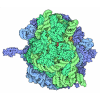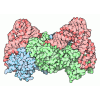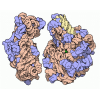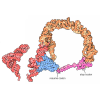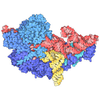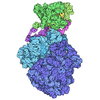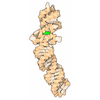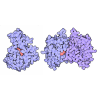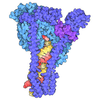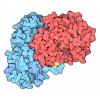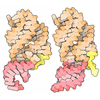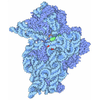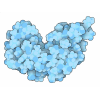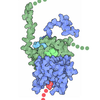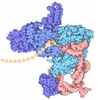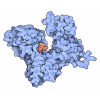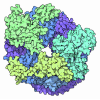+ データを開く
データを開く
- 基本情報
基本情報
| 登録情報 | データベース: PDB / ID: 8oj5 | ||||||||||||||||||
|---|---|---|---|---|---|---|---|---|---|---|---|---|---|---|---|---|---|---|---|
| タイトル | 60S ribosomal subunit bound to the E3-UFM1 complex - state 3 (in-vitro reconstitution) | ||||||||||||||||||
 要素 要素 |
| ||||||||||||||||||
 キーワード キーワード | RIBOSOME / ER / UFMylation / recycling | ||||||||||||||||||
| 機能・相同性 |  機能・相同性情報 機能・相同性情報positive regulation of I-kappaB phosphorylation / UFM1 ligase activity / UFM1-modified protein reader activity / positive regulation of reticulophagy / regulation of phosphatase activity / apoptotic nuclear changes / definitive erythrocyte differentiation / negative regulation of protein serine/threonine kinase activity / UFM1 transferase activity / positive regulation of protein localization to endoplasmic reticulum ...positive regulation of I-kappaB phosphorylation / UFM1 ligase activity / UFM1-modified protein reader activity / positive regulation of reticulophagy / regulation of phosphatase activity / apoptotic nuclear changes / definitive erythrocyte differentiation / negative regulation of protein serine/threonine kinase activity / UFM1 transferase activity / positive regulation of protein localization to endoplasmic reticulum / positive regulation of proteolysis involved in protein catabolic process / protein K69-linked ufmylation / protein ufmylation / negative regulation of protein kinase activity by regulation of protein phosphorylation / positive regulation of plasma cell differentiation / negative regulation of IRE1-mediated unfolded protein response / regulation of proteasomal ubiquitin-dependent protein catabolic process / positive regulation of cell cycle G1/S phase transition / protein localization to endoplasmic reticulum / negative regulation of T cell mediated immune response to tumor cell / negative regulation of T cell activation / regulation of intracellular estrogen receptor signaling pathway / translation at presynapse / exit from mitosis / eukaryotic 80S initiation complex / negative regulation of protein neddylation / optic nerve development / response to insecticide / regulation of translation involved in cellular response to UV / positive regulation of proteasomal protein catabolic process / axial mesoderm development / negative regulation of formation of translation preinitiation complex / regulation of G1 to G0 transition / regulation of cyclin-dependent protein serine/threonine kinase activity / ribosomal protein import into nucleus / mitotic G2/M transition checkpoint / 90S preribosome assembly / protein-DNA complex disassembly / positive regulation of intrinsic apoptotic signaling pathway in response to DNA damage by p53 class mediator / retinal ganglion cell axon guidance / cartilage development / 転移酵素; アシル基を移すもの; アミノアシル基を移すもの / ribosome disassembly / response to L-glutamate / regulation of canonical NF-kappaB signal transduction / GAIT complex / mitogen-activated protein kinase binding / positive regulation of DNA damage response, signal transduction by p53 class mediator / TORC2 complex binding / alpha-beta T cell differentiation / G1 to G0 transition / reticulophagy / regulation of neuron differentiation / middle ear morphogenesis / cytoplasmic side of rough endoplasmic reticulum membrane / negative regulation of ubiquitin protein ligase activity / negative regulation of NF-kappaB transcription factor activity / negative regulation of protein import into nucleus / homeostatic process / macrophage chemotaxis / negative regulation of PERK-mediated unfolded protein response / lung morphogenesis / mitotic G2 DNA damage checkpoint signaling / negative regulation of protein phosphorylation / male meiosis I / negative regulation of MAP kinase activity / positive regulation of natural killer cell proliferation / Protein hydroxylation / ubiquitin-like protein ligase binding / Peptide chain elongation / Selenocysteine synthesis / Formation of a pool of free 40S subunits / Eukaryotic Translation Termination / ubiquitin ligase inhibitor activity / cellular response to actinomycin D / blastocyst development / Response of EIF2AK4 (GCN2) to amino acid deficiency / positive regulation of glial cell proliferation / SRP-dependent cotranslational protein targeting to membrane / negative regulation of ubiquitin-dependent protein catabolic process / positive regulation of signal transduction by p53 class mediator / Viral mRNA Translation / RHOA GTPase cycle / Nonsense Mediated Decay (NMD) independent of the Exon Junction Complex (EJC) / protein localization to nucleus / GTP hydrolysis and joining of the 60S ribosomal subunit / hematopoietic stem cell differentiation / NF-kappaB binding / L13a-mediated translational silencing of Ceruloplasmin expression / positive regulation of protein binding / Major pathway of rRNA processing in the nucleolus and cytosol / protein targeting / ubiquitin-like ligase-substrate adaptor activity / protein-RNA complex assembly / Nonsense Mediated Decay (NMD) enhanced by the Exon Junction Complex (EJC) / endoplasmic reticulum unfolded protein response / maturation of LSU-rRNA / rough endoplasmic reticulum / Maturation of protein E / Maturation of protein E 類似検索 - 分子機能 | ||||||||||||||||||
| 生物種 |  Homo sapiens (ヒト) Homo sapiens (ヒト) | ||||||||||||||||||
| 手法 | 電子顕微鏡法 / 単粒子再構成法 / クライオ電子顕微鏡法 / 解像度: 2.9 Å | ||||||||||||||||||
 データ登録者 データ登録者 | Penchev, I. / DaRosa, P.A. / Peter, J.J. / Kulathu, Y. / Becker, T. / Beckmann, R. / Kopito, R. | ||||||||||||||||||
| 資金援助 | European Union,  ドイツ, ドイツ,  英国, 英国,  米国, 5件 米国, 5件
| ||||||||||||||||||
 引用 引用 |  ジャーナル: Nature / 年: 2024 ジャーナル: Nature / 年: 2024タイトル: UFM1 E3 ligase promotes recycling of 60S ribosomal subunits from the ER. 著者: Paul A DaRosa / Ivan Penchev / Samantha C Gumbin / Francesco Scavone / Magda Wąchalska / Joao A Paulo / Alban Ordureau / Joshua J Peter / Yogesh Kulathu / J Wade Harper / Thomas Becker / ...著者: Paul A DaRosa / Ivan Penchev / Samantha C Gumbin / Francesco Scavone / Magda Wąchalska / Joao A Paulo / Alban Ordureau / Joshua J Peter / Yogesh Kulathu / J Wade Harper / Thomas Becker / Roland Beckmann / Ron R Kopito /    要旨: Reversible modification of target proteins by ubiquitin and ubiquitin-like proteins (UBLs) is widely used by eukaryotic cells to control protein fate and cell behaviour. UFM1 is a UBL that ...Reversible modification of target proteins by ubiquitin and ubiquitin-like proteins (UBLs) is widely used by eukaryotic cells to control protein fate and cell behaviour. UFM1 is a UBL that predominantly modifies a single lysine residue on a single ribosomal protein, uL24 (also called RPL26), on ribosomes at the cytoplasmic surface of the endoplasmic reticulum (ER). UFM1 conjugation (UFMylation) facilitates the rescue of 60S ribosomal subunits (60S) that are released after ribosome-associated quality-control-mediated splitting of ribosomes that stall during co-translational translocation of secretory proteins into the ER. Neither the molecular mechanism by which the UFMylation machinery achieves such precise target selection nor how this ribosomal modification promotes 60S rescue is known. Here we show that ribosome UFMylation in vivo occurs on free 60S and we present sequential cryo-electron microscopy snapshots of the heterotrimeric UFM1 E3 ligase (E3(UFM1)) engaging its substrate uL24. E3(UFM1) binds the L1 stalk, empty transfer RNA-binding sites and the peptidyl transferase centre through carboxy-terminal domains of UFL1, which results in uL24 modification more than 150 Å away. After catalysing UFM1 transfer, E3(UFM1) remains stably bound to its product, UFMylated 60S, forming a C-shaped clamp that extends all the way around the 60S from the transfer RNA-binding sites to the polypeptide tunnel exit. Our structural and biochemical analyses suggest a role for E3(UFM1) in post-termination release and recycling of the large ribosomal subunit from the ER membrane. | ||||||||||||||||||
| 履歴 |
|
- 構造の表示
構造の表示
| 構造ビューア | 分子:  Molmil Molmil Jmol/JSmol Jmol/JSmol |
|---|
- ダウンロードとリンク
ダウンロードとリンク
- ダウンロード
ダウンロード
| PDBx/mmCIF形式 |  8oj5.cif.gz 8oj5.cif.gz | 3.6 MB | 表示 |  PDBx/mmCIF形式 PDBx/mmCIF形式 |
|---|---|---|---|---|
| PDB形式 |  pdb8oj5.ent.gz pdb8oj5.ent.gz | 表示 |  PDB形式 PDB形式 | |
| PDBx/mmJSON形式 |  8oj5.json.gz 8oj5.json.gz | ツリー表示 |  PDBx/mmJSON形式 PDBx/mmJSON形式 | |
| その他 |  その他のダウンロード その他のダウンロード |
-検証レポート
| 文書・要旨 |  8oj5_validation.pdf.gz 8oj5_validation.pdf.gz | 1.8 MB | 表示 |  wwPDB検証レポート wwPDB検証レポート |
|---|---|---|---|---|
| 文書・詳細版 |  8oj5_full_validation.pdf.gz 8oj5_full_validation.pdf.gz | 1.8 MB | 表示 | |
| XML形式データ |  8oj5_validation.xml.gz 8oj5_validation.xml.gz | 219 KB | 表示 | |
| CIF形式データ |  8oj5_validation.cif.gz 8oj5_validation.cif.gz | 383.7 KB | 表示 | |
| アーカイブディレクトリ |  https://data.pdbj.org/pub/pdb/validation_reports/oj/8oj5 https://data.pdbj.org/pub/pdb/validation_reports/oj/8oj5 ftp://data.pdbj.org/pub/pdb/validation_reports/oj/8oj5 ftp://data.pdbj.org/pub/pdb/validation_reports/oj/8oj5 | HTTPS FTP |
-関連構造データ
- リンク
リンク
- 集合体
集合体
| 登録構造単位 | 
|
|---|---|
| 1 |
|
- 要素
要素
-RNA鎖 , 3種, 3分子 578
| #1: RNA鎖 | 分子量: 1640166.875 Da / 分子数: 1 / 由来タイプ: 天然 / 由来: (天然)  Homo sapiens (ヒト) / 細胞株: HEK293T Homo sapiens (ヒト) / 細胞株: HEK293T |
|---|---|
| #2: RNA鎖 | 分子量: 38998.078 Da / 分子数: 1 / 由来タイプ: 天然 / 由来: (天然)  Homo sapiens (ヒト) / 細胞株: HEK293T / 参照: GenBank: 23898 Homo sapiens (ヒト) / 細胞株: HEK293T / 参照: GenBank: 23898 |
| #3: RNA鎖 | 分子量: 50449.812 Da / 分子数: 1 / 由来タイプ: 天然 / 由来: (天然)  Homo sapiens (ヒト) / 細胞株: HEK293T / 参照: GenBank: 555853 Homo sapiens (ヒト) / 細胞株: HEK293T / 参照: GenBank: 555853 |
-タンパク質 , 6種, 6分子 ABCDLILm
| #4: タンパク質 | 分子量: 89722.203 Da / 分子数: 1 / 由来タイプ: 組換発現 / 由来: (組換発現)  Homo sapiens (ヒト) / 遺伝子: UFL1, KIAA0776, MAXER, NLBP, RCAD / 発現宿主: Homo sapiens (ヒト) / 遺伝子: UFL1, KIAA0776, MAXER, NLBP, RCAD / 発現宿主:  参照: UniProt: O94874, 転移酵素; アシル基を移すもの; アミノアシル基を移すもの |
|---|---|
| #5: タンパク質 | 分子量: 56977.395 Da / 分子数: 1 / 由来タイプ: 組換発現 / 由来: (組換発現)  Homo sapiens (ヒト) Homo sapiens (ヒト)遺伝子: CDK5RAP3, IC53, LZAP, MSTP016, OK/SW-cl.114, PP1553 発現宿主:  |
| #6: タンパク質 | 分子量: 35663.840 Da / 分子数: 1 / 由来タイプ: 組換発現 / 由来: (組換発現)  Homo sapiens (ヒト) / 遺伝子: DDRGK1, C20orf116, UFBP1 / 発現宿主: Homo sapiens (ヒト) / 遺伝子: DDRGK1, C20orf116, UFBP1 / 発現宿主:  |
| #7: タンパク質 | 分子量: 9128.552 Da / 分子数: 1 / 由来タイプ: 組換発現 / 由来: (組換発現)  Homo sapiens (ヒト) / 遺伝子: UFM1, C13orf20, BM-002 / 発現宿主: Homo sapiens (ヒト) / 遺伝子: UFM1, C13orf20, BM-002 / 発現宿主:  |
| #16: タンパク質 | 分子量: 24552.910 Da / 分子数: 1 / 由来タイプ: 天然 / 由来: (天然)  Homo sapiens (ヒト) / 細胞株: HEK293T / 参照: UniProt: Q96L21 Homo sapiens (ヒト) / 細胞株: HEK293T / 参照: UniProt: Q96L21 |
| #45: タンパク質 | 分子量: 14758.394 Da / 分子数: 1 / 由来タイプ: 天然 / 由来: (天然)  Homo sapiens (ヒト) / 細胞株: HEK293T / 参照: UniProt: P62987 Homo sapiens (ヒト) / 細胞株: HEK293T / 参照: UniProt: P62987 |
+60S ribosomal protein ... , 40種, 40分子 LALBLCLDLELFLGLHLJLLLMLNLOLPLQLRLSLTLULVLWLXLYLZLaLbLcLdLeLf...
-非ポリマー , 2種, 225分子 


| #50: 化合物 | ChemComp-MG / #51: 化合物 | ChemComp-ZN / |
|---|
-詳細
| 研究の焦点であるリガンドがあるか | N |
|---|
-実験情報
-実験
| 実験 | 手法: 電子顕微鏡法 |
|---|---|
| EM実験 | 試料の集合状態: PARTICLE / 3次元再構成法: 単粒子再構成法 |
- 試料調製
試料調製
| 構成要素 | 名称: E3-UFM1 complex bound to the 60S ribosome / タイプ: RIBOSOME / Entity ID: #1-#49 / 由来: NATURAL |
|---|---|
| 分子量 | 実験値: NO |
| 由来(天然) | 生物種:  Homo sapiens (ヒト) Homo sapiens (ヒト) |
| 緩衝液 | pH: 7 |
| 試料 | 包埋: NO / シャドウイング: NO / 染色: NO / 凍結: YES |
| 急速凍結 | 装置: FEI VITROBOT MARK IV / 凍結剤: ETHANE |
- 電子顕微鏡撮影
電子顕微鏡撮影
| 実験機器 |  モデル: Titan Krios / 画像提供: FEI Company |
|---|---|
| 顕微鏡 | モデル: FEI TITAN KRIOS |
| 電子銃 | 電子線源:  FIELD EMISSION GUN / 加速電圧: 300 kV / 照射モード: OTHER FIELD EMISSION GUN / 加速電圧: 300 kV / 照射モード: OTHER |
| 電子レンズ | モード: BRIGHT FIELD / 最大 デフォーカス(公称値): 2000 nm / 最小 デフォーカス(公称値): 800 nm |
| 撮影 | 電子線照射量: 50 e/Å2 フィルム・検出器のモデル: GATAN K3 BIOQUANTUM (6k x 4k) |
- 解析
解析
| CTF補正 | タイプ: PHASE FLIPPING AND AMPLITUDE CORRECTION |
|---|---|
| 3次元再構成 | 解像度: 2.9 Å / 解像度の算出法: FSC 0.143 CUT-OFF / 粒子像の数: 35935 / 対称性のタイプ: POINT |
| 原子モデル構築 | プロトコル: AB INITIO MODEL |
 ムービー
ムービー コントローラー
コントローラー











 PDBj
PDBj